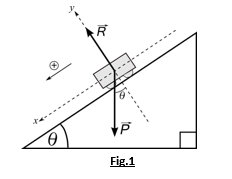PW 3 : NEWTON'S LAWS
I. GOALS :
- Study the variation of the position of a body, moving on an inclined plane, as a function of time.
- Experimental calculation of the earth's gravitational constant g.
- The calculation of the dynamic coefficient of friction µd .
- The calculation of the static coefficient of friction µs .
II. USED MATERIAL :
- A carriage whose mass m is labeled above.
- An inclined plane of length L = 100 cm.
- A friction block.
- Two optical forks.
- A graduated ruler.
- A digital stopwatch
III. THEORY :
III.1. Movement without friction :
A carriage of mass m slides on an inclined plane that makes an angle with the horizontal plane (see Fig.1).
The fundamental principle of dynamics (FPD), neglecting the effects of plane friction, allows us to write:![]()
![]()
The projection
on the axis of movement x, gives us : The equation of
motion of the carriage can be written in the form : Hence, the
expression of the distance d traveled by this trolley, for an initial
speed of zero (v0 = 0)
is : III.2.
Movement with friction : The
carriage is now replaced by a friction block. This block is released, without
initial speed, from the top of the inclined plane (see Fig.2). The application of FPD principle gives us: f
being the
frictional force which is added in this case and a' is the acceleration
vector. Projecting equation
(3) onto the x axis, we
get: µd is the dynamic coefficient of
friction.
The projection of equation (3) on the
axis, gives
us : The equation of
motion of the carriage can be written in the form: Hence the expression of the distance
traveled by
this block, for an initial speed of zero ( v0 =0) is : In this part, we vary
the distance between the two optical forks and we measure the time necessary
for the carriage to travel this distance, taking an initial speed of zero. 1. Set the angle of inclination of
the plane to 5°. 2. Place the carriage on the plane, so that its
cursor is at the limit of the beam of the optical fork. This is the device that
starts the stopwatch. If this instruction is not respected, the results will be
falsified by the non-zero initial speed of the carriage when the stopwatch is
started. 3. For different distances d of increasing values between the two optical forks (see the table in
the TP-sheet), measure the corresponding times t. For each
distance, take a minimum of three measurements (each student will take one
measurement). When the carriage cursor crosses the beam of the second optical
fork, the stopwatch stops and it displays the time elapsed for crossing this
distance. Record your results in the measurement table. 4. On a millimeter sheet, draw the requested curve. IV.2.1. Determination of the dynamic coefficient of friction : 1. Consider the previously used device. 2. Set the angle of inclination of the plane to
20°. 3. Replace the carriage with the friction block.
4. Put the block on the side that contains a
single face of felt. 5. The block must be placed on the plane, so
that its cursor is at the limit of the beam of the optical fork. 6. Drop the block with no initial velocity. Measure
the duration (time) of the movement for the different distances between the two
optical forks (see the table in the TP-sheet). Record your results in the
measurement table. 7. On a millimeter sheet, draw the
required curve. IV.2.2. Determination of the coefficient of static friction : 1. Take the previously used device. 2. Set the angle of inclination of the plane to
0°. 3. Increase the angle of the incline until the
block slides. Note the value of the angle. 4. Calculate the coefficient of static friction. 1. Determine the expression of the acceleration
for the movement without friction (case III.1.) of the carriage
depending on the earth's
acceleration g
. 2. Determine the expression of the acceleration
for the movement with friction (case III.2.) of the carriage
depending on the earth's acceleration
and the coefficient of dynamic
friction µd
. 2. Determine the expression for the coefficient
of static friction µs
depending on the angle of the
inclined plane
. ![]()
![]()
![]()

![]()
![]()
![]()
![]()
![]()
IV. EXPERIMENTAL PROCEDURE
IV.1.
Movement without friction :
IV.2. Movement with friction :
V. THEORETICAL
QUESTIONS (IMPORTANT) :
